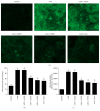Dahuang Fuzi Decoction Attenuates Renal Fibrosis and Ameliorates Mitochondrial Dysfunction in Chronic Aristolochic Acid Nephropathy
- PMID: 28421124
- PMCID: PMC5379088
- DOI: 10.1155/2017/9536458
Dahuang Fuzi Decoction Attenuates Renal Fibrosis and Ameliorates Mitochondrial Dysfunction in Chronic Aristolochic Acid Nephropathy
Abstract
Objectives. The effects of the traditional formula Dahuang Fuzi Decoction (DFD) on chronic aristolochic acid nephropathy (AAN) in mice and its underlying mechanisms were studied. Methods. Mice were randomly divided into the following six groups: the control group, the model group (AAN), the saline-treated group (AAN + vehicle), the normal dose DFD-treated group (AAN + NDFD), the high dose DFD-treated group (AAN + HDFD), and the rosiglitazone treated group (AAN + Rosi). After treating for 8 weeks, 24 h urine and blood samples were collected and the mice sacrificed to study the biochemical parameters associated with renal function. The samples were analyzed for renal fibrosis and mitochondrial dysfunction (MtD) markers. To achieve that, collagen III, collagen I, mitochondrial DNA copy numbers (mtDNA), mitochondrial membrane potential (MMP), ATP content, and ROS production were evaluated. Results. Our results showed that proteinuria, kidney function, and the renal pathological characteristics were improved by DFD and rosiglitazone. The expression of collagen III and collagen I decreased after treating with either DFD or rosiglitazone. Mitochondrial dysfunction based on the increase in ROS production, decrease in mitochondrial DNA copy numbers, and reduction of MMP and ATP content was improved by DFD and rosiglitazone. Conclusions. DFD could protect against renal impairments and ameliorate mitochondrial dysfunction in chronic AAN mice.
Figures




Similar articles
-
Dahuang Fuzi Decoction ameliorates tubular epithelial apoptosis and renal damage via inhibiting TGF-β1-JNK signaling pathway activation in vivo.J Ethnopharmacol. 2014 Oct 28;156:115-24. doi: 10.1016/j.jep.2014.08.035. Epub 2014 Sep 3. J Ethnopharmacol. 2014. PMID: 25193680
-
Possible role of mitochondrial injury in Caulis Aristolochia manshuriensis-induced chronic aristolochic acid nephropathy.Drug Chem Toxicol. 2017 Jan;40(1):115-124. doi: 10.1080/01480545.2016.1188303. Epub 2016 Jun 2. Drug Chem Toxicol. 2017. PMID: 27250112
-
Aristolochic acid nephropathy and the peritoneum: Functional, structural, and molecular studies.Kidney Int. 2003 Nov;64(5):1883-92. doi: 10.1046/j.1523-1755.2003.00275.x. Kidney Int. 2003. PMID: 14531824
-
An Integrated View of Aristolochic Acid Nephropathy: Update of the Literature.Int J Mol Sci. 2017 Jan 29;18(2):297. doi: 10.3390/ijms18020297. Int J Mol Sci. 2017. PMID: 28146082 Free PMC article. Review.
-
[Case of traditional herbal medicine-induced aristolochic acid nephropathy developing to end-stage renal failure].Nihon Jinzo Gakkai Shi. 2005;47(4):474-80. Nihon Jinzo Gakkai Shi. 2005. PMID: 15971892 Review. Japanese.
Cited by
-
Overview of aristolochic acid nephropathy: an update.Kidney Res Clin Pract. 2023 Sep;42(5):579-590. doi: 10.23876/j.krcp.22.211. Epub 2023 Jun 15. Kidney Res Clin Pract. 2023. PMID: 37448287 Free PMC article.
-
The Network Pharmacology Study of Dahuang Fuzi Decoction for Treating Incomplete Intestinal Obstruction.Biomed Res Int. 2022 Apr 28;2022:2775434. doi: 10.1155/2022/2775434. eCollection 2022. Biomed Res Int. 2022. PMID: 35528155 Free PMC article.
-
Therapeutic Implications of Ferroptosis in Renal Fibrosis.Front Mol Biosci. 2022 May 17;9:890766. doi: 10.3389/fmolb.2022.890766. eCollection 2022. Front Mol Biosci. 2022. PMID: 35655759 Free PMC article. Review.
-
Simiao pill inhibits epithelial mesenchymal transition in a mouse model of chronic hyperuricemic nephropathy by inhibiting NLRP3 inflammasome activation.BMC Complement Med Ther. 2022 Oct 21;22(1):278. doi: 10.1186/s12906-022-03757-0. BMC Complement Med Ther. 2022. PMID: 36271349 Free PMC article.
-
Effects and Mechanism of Oxymatrine Combined with Compound Yinchen Granules on the Apoptosis of Hepatocytes through the Akt/FoxO3a/Bim Pathway.Biomed Res Int. 2022 Jan 6;2022:8644356. doi: 10.1155/2022/8644356. eCollection 2022. Biomed Res Int. 2022. PMID: 35036441 Free PMC article.
References
-
- Debelle F. D., Nortier J. L., De Prez E. G., et al. Aristolochic acids induce chronic renal failure with interstitial fibrosis in salt-depleted rats. Journal of the American Society of Nephrology. 2002;13(2):431–436. - PubMed
LinkOut - more resources
Full Text Sources
Other Literature Sources

